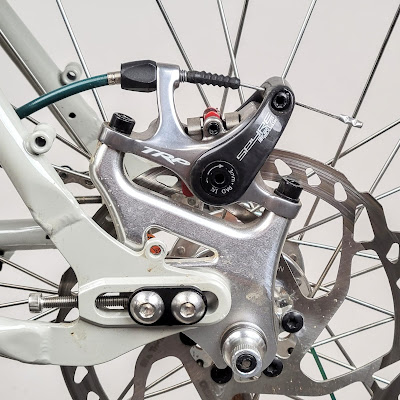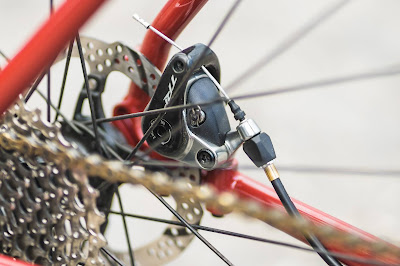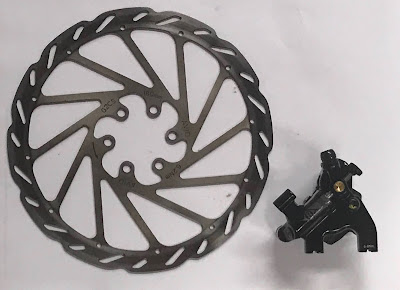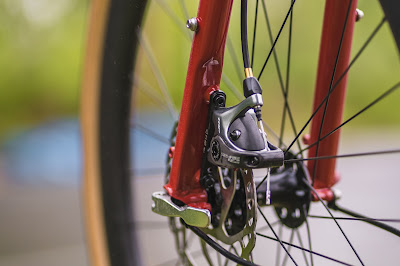Disc brakes have really made major inroads into road cycling since they were first introduced about 15 years ago. Where once the idea of a road bike using disc brakes was laughable, we've now reached the point where a large percentage of road bikes come with disc brakes. We'd done a blog post about the pro/cons of disc brakes awhile back, so we're not here to rehash an old argument, but rather try to explain what you need to get in terms of brakes and bits if you want to build up a new bike that takes disc brakes.
Let's start with the mounting style of the brake caliper. This is the key to buying the right parts for your bike. There are three main styles you'll read about: IS, Post, and Flat mount. In your bike's description, it should state what sort of disc brake system the frame and fork uses.
- IS mount uses an unthreaded tab welded to the frame or fork. "IS brakes" do not exist anymore. The Polyvalent and Piolet use IS mounts. What you need to buy is a post-mount brake and an IS adaptor for your rotor size. Generally speaking, when you choose the rotor, use the adapter the company who makes the rotor suggests.
-
Post mounts are welded tabs that have internal threading. The brake screws right into the mount in the frame. You get adaptors to account for the size of the rotor. These were designed for mountain bikes, so you can get adapters to work with rotors from 160 mm to 203 mm. Our Neutrino mini velo uses this system for the rear brake and an IS for the front.
- Flat mount is flush/flat with the chain stay or fork. It was designed for road and gravel bikes but is making its way into MTB. Typical rotor sizes are either 140 and 160 mm. Our Pass Hunter has flat mount brakes.
Moving on to Calipers...
There are generally two styles of caliper. The first is single piston, where one side moves the brake pad and pushes the rotor against the other pad on the opposite side of the caliper. The other is dual piston where a single arm actuates pistons on both sides of the rotor (more like your car's brakes). Either is fine, but we prefer to use dual piston for more consistent wear and performance of brake pads and rotors.

There are several types of actuation among disc brakes. Perhaps the most common are mechanical, cable-actuated calipers. These are nice for swapping cockpits and brake components. Alternatively, you can also get hydraulic brake calipers. These offer greater stopping power and better modulation, though you generally can't mix and match components from different companies, or even series from the same company. There are also more specialized tools for installation since you're dealing with hydraulic fluid. The third type is a cable actuated brake with a hydraulic reservoir. This type of brake offers the benefit of being able to mix and match calipers and brake levers, while also offering greater stopping power and modulation than a standard mechanical caliper. Simply put:
-
Cable actuated: easy to install and service, able to mix and match, good braking
-
Hydraulic actuated: harder to install and service since you need specialized tools, essentially no ability to mix and match, superior performance and modulation
-
Cable actuated with hydraulic reservoir: easy to install and service, able to mix and match, great braking, though more bulky than the other options because of the added reservoir
And Rotors...
The rotor is the actual disc that the brake caliper pinches to allow you to stop. Generally speaking, when choosing rotor size, larger rotor equals better heat removal and better stopping over short/intense braking (MTB) and longer downhill braking. Smaller rotor equals less weight and fewer parts. Generally speaking, the bikes we built fluctuate between 160mm or 180mm depending on the application and bike. The next size up is 203mm, but that is pretty exclusively for MTB and downhill.
Rotors come in two mounting styles - 6 bolt (on left) or center lock (on right). 6 bolt is the style we use on
our hubs. The big advantage to 6 bolt is that you can easily remove the rotor if you are packing the bike up or need to replace the rotor out in the wilds of Iceland's interior, using only a T25 Torx head wrench.
The center lock system, which is primarily used and licensed by Shimano, uses a center spline with a lock ring to keep the rotor in place. You need a cassette lockring tool plus a good size wrench to get it off. This is nice for installation but is a pain for traveling.
Finally Adaptors...
So let's look at a fork to get an idea of the parts needed for it. This fork uses IS mounts, so we went with a set of Post mount TRP Spyres and the mounts for a 160 mm rotor. Notice that the fork mount is unthreaded, and the adaptor is threaded in two directions: left and right to attach the caliper to the fork mount, and front and back to attach the caliper to the adaptor.
Flat mount is a little different. For the frame, you need bolts that pass through the frame and screw into the caliper. Depending on the frame design, you may not need any shims for a 140mm rotor. For a 160mm rotor, you'll very likely need one. For the front, it also screws directly into the fork and uses a special mount. Some brake sets come with all of the hardware and others don't come with any (and you have to buy a la cart).
Post mount is the easiest as the caliper screws directly into the frame or fork mount. You should only need shims to accommodate the rotor size.
















